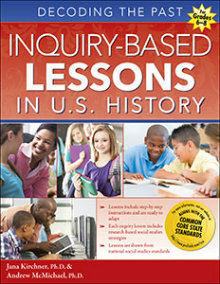Inquiry-Based Lessons in U.S. History
Inquiry-Based Lessons in U.S. History: Decoding the Past
By Jana Kirchner, Ph.D. and Andrew McMichael, Ph.D.
(Prufrock Press, 2015 – Learn more)

With the last weeks of summer in view, as you complete courses, professional development and travel, the last thing you need is to add another book to your ever-growing list of books to read. I have good news and bad news for you. The bad news is I have another excellent and useful book I want you to add to your list, but the good news is that it is a reference book that does not have to be read cover-to-cover to truly appreciate or get use from.

More about the book
The introduction states that the authors rely on the National Center for History in the Schools standards for United States history (grades 5-12) but incorporate aspects of the C3 Framework inquiry arc:
- Developing Questions and Planning Inquiries
- Applying Disciplinary Concepts and Tools
- Evaluating Sources and Using Evidence
- Communicating Conclusions and Taking Informed Action
The opening of each chapter begins with a few pages of pertinent historical background and the standards that will be addressed. Then it is followed by a lesson plan that is set up the same way throughout the book – Organizing Question, Strategies Used, Materials Needed, Lesson Plan.
For most of the primary sources a link to a website is provided. The authors state that they have used stable websites, and all the links I tried worked for me. If an excerpt from a source is used for a lesson, then the excerpt is included in the book. Also, if an organizer is used for a lesson, it is provided and can be copied easily.
For example in Chapter 9 on Reconstruction the lesson is set up as follows:
► Organizing Question: What problems existed at the end of the Civil War?
► Strategies Used: Think Aloud, Gallery Walk
► Materials Needed: A list of sources used and an organizer (the organizer and a handout on Civil War casualties are included after the lesson and can be photocopied)
► Lesson Plan: the hook, further explanation of the Organizing Question, Examining the Sources, and Make a Hypothesis
The bottom line
If you are looking for new ways to incorporate primary sources into your U.S. history lessons, then this book will provide you with some great ideas. From the nation’s infancy through Civil Rights you will have access to great lessons or can take the bits and pieces you need. I can honestly say that no U.S. history teacher would be disappointed with this book. It can serve you to have as a personal copy or to keep in a curriculum library.
Michael DiClemente is a sixth grade Social Studies teacher at Andrews Middle School in Medford, Massachusetts. Michael has a master’s degree in history and is involved in the local historical community. He presents a few times a year at local history conferences. Michael has become increasingly involved in the National Council for the Social Studies, the Massachusetts Council for the Social Studies, and the local council.



































